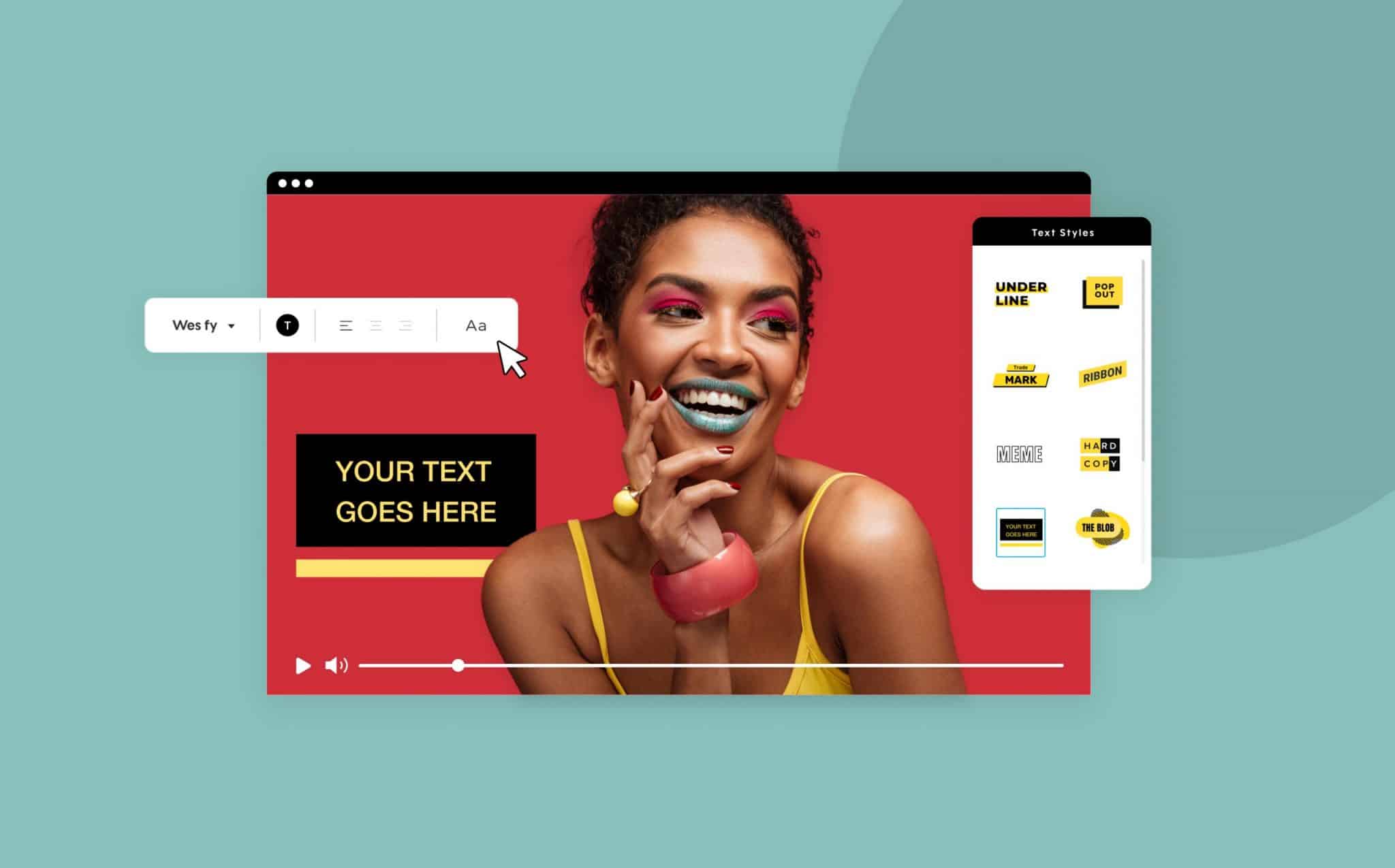
How to Add Subtitles to a Video

- Blog
- Video Editing Tips
- How to Add Subtitles to a Video
It’s no longer a secret that video has become a powerful medium for driving audience engagement. As you look to expand your digital marketing efforts and reach a broader, global market, adding subtitles to your video can elevate your brand and make your videos super successful. With more and more viewers favoring online videos, subtitles have become an important tool for making videos more inclusive, accessible, and engaging. In fact, there’s been a noticeable increase in its usage across digital media platforms.
According to the BBC, 35% of online viewers use subtitles for digital videos. Facebook revealed that using subtitles increased video ad views by 12%. That is not surprising, as research reveals that a staggering 85% of all Facebook videos are watched without sound.
If you aim cut and promote your video to reach a wider audience and boost video engagement, it’s about time you incorporate subtitles into your video marketing toolkit. Not sure how to get started? We’ve got you covered.
In this article, we’ll show you how to add subtitles to your video. You’ll also learn the difference between subtitles and closed captions and when to use them.
Why Subtitles?
Whether you’re creating explainer videos, training or educational content, and video type, subtitles can and will have a huge impact on how successful they turn out. They make your content viral and accessible to a broader audience.
But that’s not all. Here are some of the other benefits of using subtitles in videos and why you should add a subtitle editor to your video editing toolbox.
Increase Engagement
As a video creator or filmmaker, you’ll agree that having viewers tune out of your videos could be your worst nightmare. However, this could happen when your audience struggles to connect to the message due to language barriers, being hard of hearing, or watching videos on mute.
Video engagement determines how valuable and effective your videos are and could be measured in terms of views, watch time, shares, likes, and more. It’s also the primary factor that determines how much value your viewers get out of your video.
Using subtitles for videos is a proven way to add value and increase engagement with your audience across several social platforms. That’s because it enables you to communicate with your audience in the language they understand. Beyond adding a different element (text) to the viewing experience, subtitles ensure your audience doesn’t miss out on information contained in your video.
Here’s what you should know. Viewers love a well-rounded viewing experience made up of visuals, audio, and text. Plus, they’re more likely to view, engage, recall and rewatch videos that resonate with them and deliver the message in a clear manner.
In a study, Instapage found that Facebook videos with subtitles had a higher view time (5%) and were viewed by more people (3%) than those without subtitles. With the stats above, there’s no doubt that video subtitles have the potential to bring a jump in engagements.
Accessibility
Having great videos on the internet is not enough. They should be accessible to a broader audience, including people who face language barriers, hearing difficulties, or can’t turn sound on. That’s what subtitles bring to the table.
Adding subtitles to your video and sharing them opens it up to a wider audience. Not only that, but it transcends language boundaries, allowing more and more people to engage with your brand globally.
Let’s show you how subtitles make your videos more accessible to two categories of people.
Deaf and Hard of Hearing People
Research has shown that more than 28 million American adults are deaf or hard of hearing. The World Health Organization reports that 5% of the World’s population (430 million people has disabling hearing loss. So what does this mean for your brand? Well, as you’d expect, this category of people cannot hear sound and primarily rely on captions to get information from video content.
So if you don’t add subtitles to your video, you’ll miss the opportunity to reach or sell your brand to a large percentage of your potential target audience.
People Who Watch Videos On Mute
Most people with normal hearing prefer to watch videos without sound. According to a study, 85 percent of Facebook videos are watched on mute. Plus, one-third of Snapchat videos are played with sound off.
Of course, this trend may be due to many reasons. It could be because they’re in a public place or listening to something else and don’t want to turn it off. Whatever the case, one thing is sure. They’ll undoubtedly appreciate subtitles. By using subtitles in your social videos, your audience can easily binge your content on the go without turning sound on, leading to more engagements for your brand.
Calls to Action
Whether you’re looking to increase traffic, conversions, leads, or sales, calls to action (CTA) is a weapon for triggering viewers’ action. Depending on your conversion goals, your CTA could be for your audience to:
- Download a software
- Sign up for a newsletter or get a free trial
- Buy a product
- Subscribe to your channel and watch other videos
- Share your video on social media
Regardless of what your CTAs are, you want to ensure they are crystal clear, visible, and easy to understand. But how do you ensure your entire audience understands your CTA considering that some people grasp more information via text while others prefer visuals or audio?
Because subtitled videos use a combination of visuals, sound, and text, they offer a complete viewing experience. Not only that, they bring more context to your video, making it fool-proof for anyone to grasp the information contained in it.
The results? In a study, Instapage found that CTA click-throughs dropped by 26% when subtitles were removed from videos. This shows that subtitles are a perfect tool for increasing engagement and conversions for your business. They hold your audience’s attention and ensure they don’t miss out on critical information like CTAs that can engage and nudge them to take action.
Search Engine Optimization
Using subtitles for video is a proven SEO optimization strategy. It has a two-fold way of indexing your videos and giving them a higher chance of ranking on search engines.
- Increases engagements and social shares to boost searching rankings
- Search engines crawl and index video subtitle text to increase search rankings
First, as we’ve mentioned earlier, subtitles improve how people view, engage, and react to your video content. The results are evident in terms of boosting engagement and social shares. But how does video performance relate to SEO? When your videos perform well in terms of views, watch time, clicks, bounce rate, and shares, search engines (Google, YouTube) will automatically mark them as helpful content. Plus, they’ll increase the video’s ranking for related search terms and serve it to more people.
Search engine algorithms or bots generally rank online content based on its relevance to users’ search queries. And when it comes to videos, they rely on text (not video) to index and understand what it’s all about. So, in addition to your video description and title text, subtitle text offers more detail about how useful your video is and optimizes it for search. With the extra details in place, Google or YouTube will find your video more relevant. It will also ensure your video ranks higher for related search terms than other videos (without captions), focusing on the same subjects and keywords.
How to Add Subtitles to a Video with Promo.com
Want to make videos that stop the scroll and get the views flowing? If the answer is yes, then a feature-rich video subtitle maker like Promo is your best bet. The software helps you create interesting content with a rich blend of visuals, sound, and text… just the way your viewers love it.
With over 50 custom-designed animated text styles and hundreds of fonts, Promo’s subtitle editor makes it super-easy for just anyone (regardless of their skill level) to add subtitles to a video.
So if you’re looking to increase your video impact with accurate subtitles that keep your audience engaged, here’s how to do that with Promo:
1. Upload the video you want to subtitle to Promo.com (or create a new video with Promo in minutes).
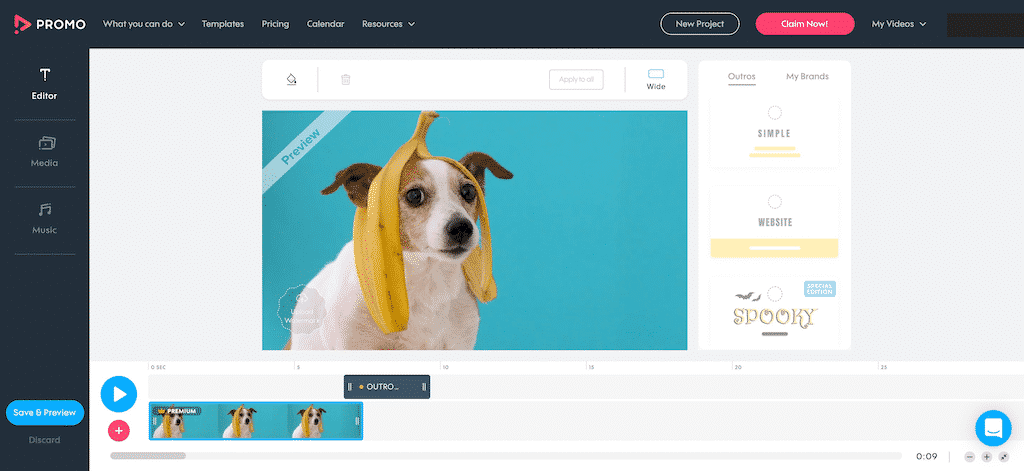
2. Once you’ve uploaded a video to Promo’s video editor, click the round pink plus sign (+) on the left of your video timeline.
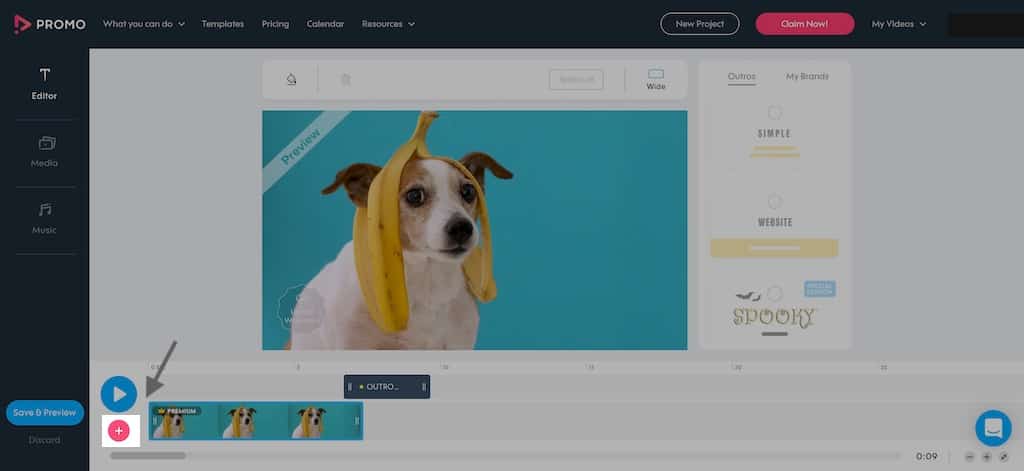
3. Go ahead and select “Add Caption” from the dropdown menu, and a new text box will appear on your timeline above the footage. On the right-hand side, our custom text styles will now be present. You can choose any text-style you like, but we recommend the “subtitle” font which is at the bottom section once you scroll down.
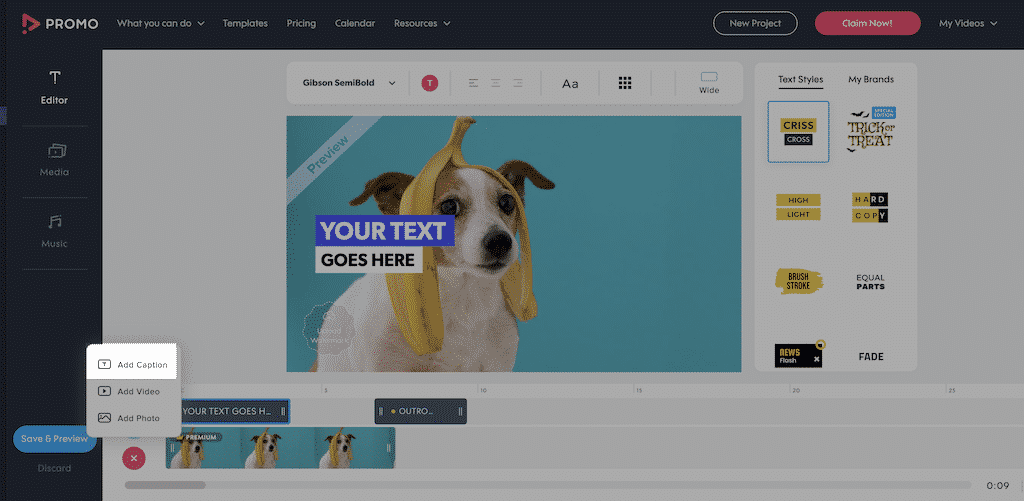
4. Next, edit and design your subtitle in the frame using a wide range of text styling options in the subtitle editor. You can choose from over 100 fonts, upload your own brand font and play with the colors as much as you like. All customization options are available on the bar above your video.
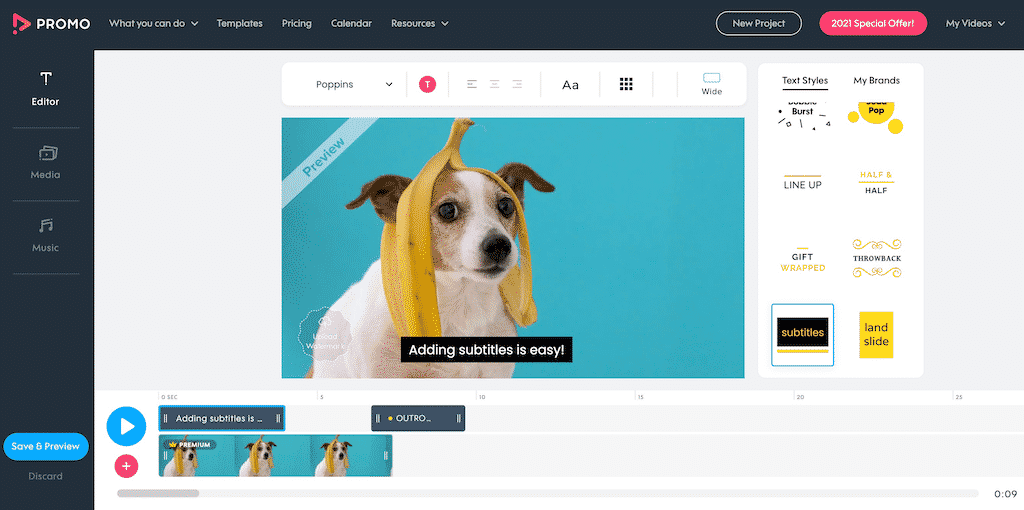
5. Ready to move on to the next frame? To use the same font and text style, hover on the first subtitle text box on the timeline. You’ll see three dots, click on them and choose “duplicate”.
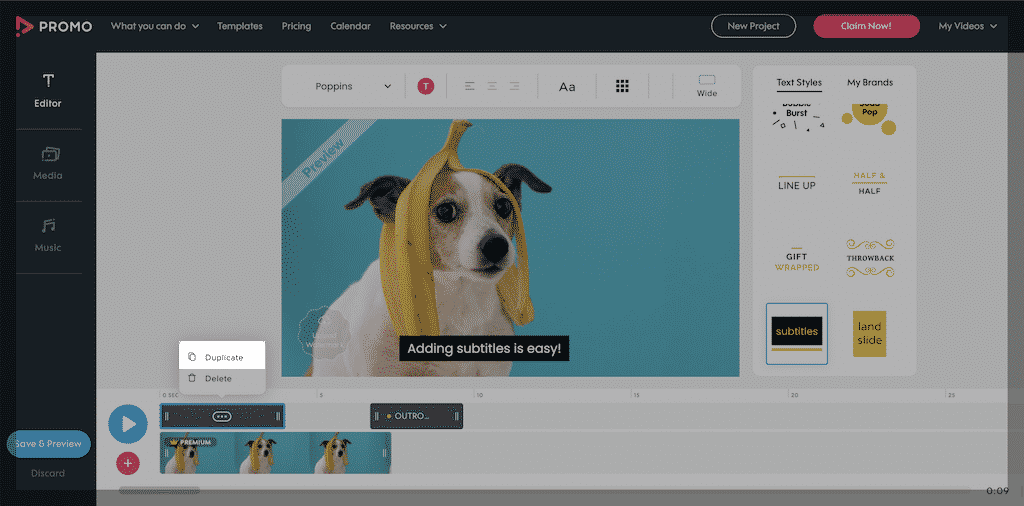
5. After you’ve precisely placed and styled your subtitle with beautiful text and colors, click on Save & Preview to view your video, publish to social platforms or download them to your local device.

Power of Visual Text
If you’re looking to reach or market your brand to a global audience, you’d have to think beyond serving videos in your native language.
It’s the year 2021, and international boundaries or language barriers shouldn’t restrict your brand. And that’s because making and distributing video content that connects and resonates with a global audience has never been easier.
But how do you make your content cuts across different languages without breaking the bank?
The short answer is subtitles, video captions, or text translations.
Without subtitles, people who don’t speak or understand the language your video is in may have trouble understanding. However, captions tend to slow things down and allow them to digest the content better.
Plus, making subtitles is a cheaper and better alternative, rather than going through the lengthy process of creating audio translations in different languages (more expensive and time-consuming). With video captioning, people all over the world can watch and interact with your videos without language barriers.
Take Advantage of the Auto Play
The video autoplay feature on social platforms like Facebook, Instagram, etc., is changing how viewers engage with video content. With auto-start videos, viewers have no choice but to catch a glimpse of it (including those who weren’t intending to watch).
This feature makes Video even more of an opportunity for brands to boost their audience engagement and expand their reach. However, it all starts with making the first few seconds of your videos count. To grab audience attention, first, you need to make sure the first 30 seconds of your videos are captivating. Your audience should be hooked on your content and eager to follow through to the end.
Adding subtitles to your videos is also a great way to use autoplay to your advantage. Some viewers (especially mobile audiences) prefer to watch videos on mute for different reasons.
But this doesn’t mean you can’t tell your story with sound off.
Adding subtitles to video will help viewers digest the information in your content, especially in the first few seconds, even while it’s on mute. This will, in turn, drive CTAs and increase conversions for your brand.
What’s the Difference? Subtitles VS Closed Captions
Subtitles and closed captions have been around for many decades. And many years down the line, they continue to provide immense support for video creators and viewers alike.
Both subtitles and closed captions translate spoken audio into a written language the viewer will understand. They have become a staple for reaching wider audiences, and almost every major video streaming platform (Netflix, YouTube, Hulu, Amazon Prime, Free Hotstar VIP, etc.) supports them.
At a glance, captions and closed captions appear similar or serve the same purpose. However, there are subtle differences that set them apart. Before we dive into the subtitles vs closed captions debate, here’s what you should know. Choosing between subtitles and captions depends on your target audience and how they’ll digest your video content.
Let’s take a quick look at the differences between subtitles and captions.
What Are Subtitles?
Subtitles are living transcriptions or translations of the dialogue in your video. They give your viewers a complete visual experience and real-time insight into what the characters are saying.
Subtitles appear at the bottom of the screen in sync with the conversation that’s happening in the video. By adding subtitles to videos, your viewers can keep up with the action, even when they don’t understand the language or can’t correctly decode a character’s accent.
The thing about subtitles is that it assumes that the viewer can hear sound. Hence, it primarily focuses on the conversation between characters rather than other audio elements like background music and sounds.
What Are Captions?
Much like subtitles, captions translate narrations and dialogue in your video. However, video captioning takes it a step further by transcribing sounds, music, gestures, notifications, and speaker identity into written text. This enables your audience, including deaf or hard of hearing, to engage better with your content.
Captions can be further split into two main categories, including open and closed.
Open (or hardcoded) captions are embedded into the video stream so users can’t turn it off. On the other hand, closed captions give viewers the freedom to either turn on or off. As a video maker or filmmaker, you should know the difference between subtitles and closed captions and when to use them.
Both captions and subtitles provide valuable information to help viewers engage and enjoy your video. However, if you want your audience to read subtitles with ease and enjoy their viewing experience, styling is a key factor you should pay attention to.
They play a massive part in how effective your subtitles are and how viewers access your video. For instance, if you’re creating explainer videos, using tiny font sizes or illegible font styles may make your subtitles difficult to read or understand.
Want to create subtitles that keep your viewers hooked on your video? Here are some subtitle styling tips you should keep in mind.
Choose the Right Subtitle Font
While creating your subtitles, choose fonts that are clear and readable. Using legible fonts will help your audience read the subtitles easily without distracting their focus from the video content.
Beyond readability, it’s important to use fonts that match the style and tone of your video. Every font has a distinct personality and serves a unique purpose. For example, different fonts are used in different industries or settings and can influence the reader’s perception of the information in your video. Hence we recommend choosing a font and color that best depicts your content, brand, and industry.
When it comes to choosing subtitle fonts, there is a sea of options available to you. For example, Promo subtitle editor offers hundreds of font types to help you customize the look and feel of your subtitle.
So what’s the best font for subtitles?
Arial is one of the most popular picks for subtitles because of its readability and widespread use by creatives. Its use cuts across formal, contemporary, modern, elegant, and classic settings.
Roboto is another excellent font choice for captioning your video. Not only is it free and open-source, but it’s also the default font type for YouTube captions. Because Roboto is less bulky, it’s suitable for writing long sentences.
Other excellent fonts for creating video subtitles include Times New Roman, Verdana, Helvetica, Futura, Consolas, etc.
Depending on the device the video is being viewed, font sizes may also affect subtitle readability and clarity. So you’d want to optimize the size of your subtitles for different screen types (mobile and desktop) so that they can be read easily.
Add a Stripe Under the Subtitles
Placing a background stripe under your subtitles is one of the easiest ways of making your video subtitles legible.
However, before using this option, ensure that your text style, color blocks, and stripe blend in nicely to enable your subtitles to stand out. For instance, if you use a dark-colored stripe, it’d only make sense to use bright-colored fonts to make your subtitles readable.
One potential disadvantage of this method is that if your subtitle editing software does support this feature, it can be time-consuming to resize the stripe for each video frame and subtitle–especially if you have a lot of them.
Subtitle Placement
Poorly placed subtitles can interfere with some vital information in your video, distract your audience and distort viewing. The most widely accepted placement for subtitles is at the bottom of the screen. This ensures that the text doesn’t obscure any important on-screen action.
However, in cases where there’s important information at the lower part of the screen (like character names, game scores, or statistics), you can move the subtitle to the top. To achieve this, you need a flexible subtitle maker like Promo that lets you .position your subtitles wherever you like.
Do Even More With Our Subtitle Editor
Beyond creating subtitles, there’s so much more you can do with Promo.com to further enhance your content, boost engagements, and increase conversions. The software enables you to:
- Create stunning videos online for different purposes (explainers, social media ads,
- Edit multiple videos online
- Add quality stock images, music, and sound effects
- Merge, trim and resize your videos to fit any social media platform (Facebook, Instagram, Twitter, TikTok, etc.)
- Reduce your video file sizes
- Engage, inform and entertain your follower with quality editorial content and more
Why Use Promo.com Over FB, IG, YT, and TikTok Built In Editors?
Most video streaming and social platforms like Facebook, Instagram, YouTube, and TikTok offer built-in subtitle editors. However, these editors serve machine-generated captions, which are rarely accurate. They tend to confuse audiences and could negatively impact your video engagement and ROI.
What’s more? Built-in subtitles are limited in terms of the subtitle features and customization options (placement, styling, branding) available to users.
Besides being an intuitive and complete video-making tool, Promo.com supports subtitling, editing, and many more advanced features that other video editors just can’t compete with.
With Promo’s video subtitle maker, you can:
- Upload videos in different file formats and sizes, ensuring that no video is left behind
- Add video captions or subtitles straight from your browser.
- Access hundreds of fonts, dozens of animated text presets, color options, and other subtitle styling options.
- Add subtitles across multiple frames with a few clicks and place the captions wherever you like to make it accessible and readable, and much more.
Frequently Asked Questions
How do I choose between subtitles vs closed captions?
Although subtitles and closed captions are often used interchangeably, they serve different audiences. The best choice for your video depends on who your viewers are.
If your audience is deaf, hard of hearing, or can’t hear both speech and non-speech elements like sounds, music, notifications, gestures, closed captions will make your video accessible.
On the other hand, if your audience can hear audio but don’t understand the language and dialogues in the video, subtitles will do the trick.
What is the best font for subtitles, and why?
The best fonts for subtitles are the ones that are clear and legible. Fonts like Arial, Roboto, Times New Roman, Verdana are popular choices among video creators because they are readable. In addition, legible fonts like Helvetica, Futura, Consolas are also excellent choices for making captions, etc. With Promo subtitle editor, you’ll find hundreds of readable fonts for captioning your videos, so you’re spoilt for choices.
How to add subtitles to videos in different text sizes
Most subtitle editors like Promo allow you to add subtitles to video and adjust font sizes to further improve readability. To customize your subtitle text, upload your video to Promo.com’s subtitle editor. Click ‘+’ to the left of the timeline and insert text. There you’ll find different options for styling for your text, including increasing or reducing font sizes.
Once you’ve adjusted the text to your preferred size, click Save & Preview to download or publish it to different platforms.
Which is the most efficient and easy-to-use subtitle editor?
Promo.com offers an industry-leading subtitle editor that’s intuitive and fool-proof. The tool has a wide range of features that allow users to create, customize, and add subtitles to video without prior video design or editing experience.
Style Your Video Subtitles
Promo's video editor gives you the freedom to choose from over 100 subtitle fonts, and even upload your own!
About the author
Promo Team
We believe that words shape thoughts and inspire action. Promo's content team is fueled by the motivation to help you to transform your words and ideas into powerful videos that help you communicate better with your audience and grow your reach.


